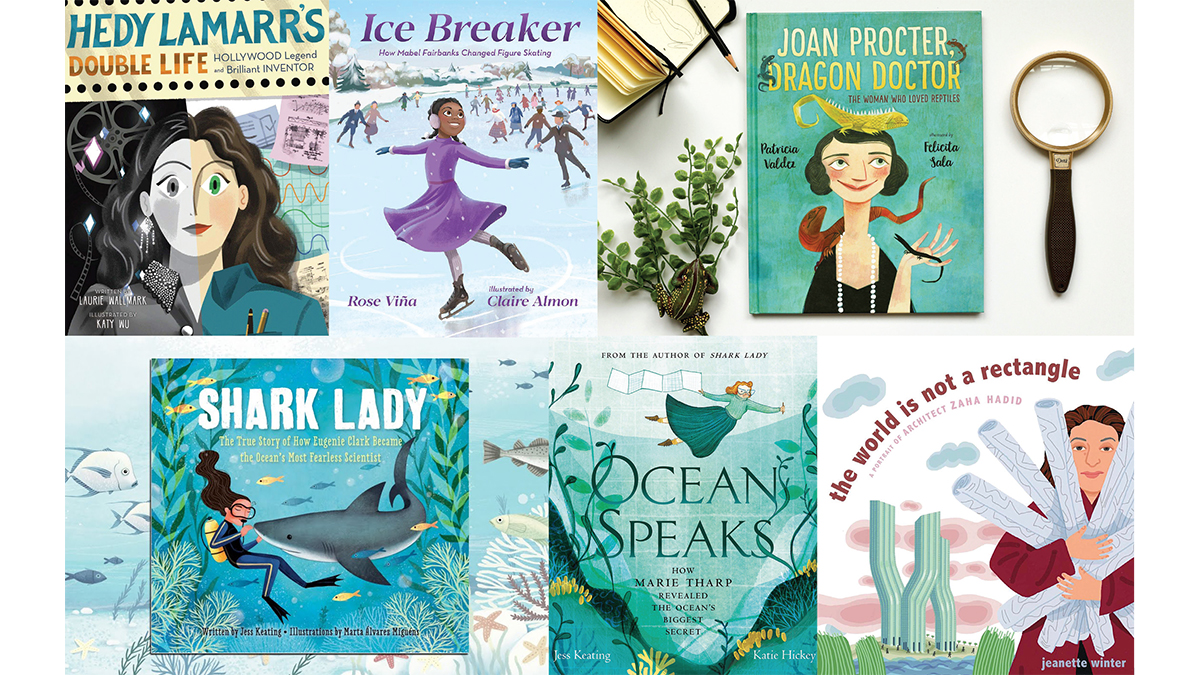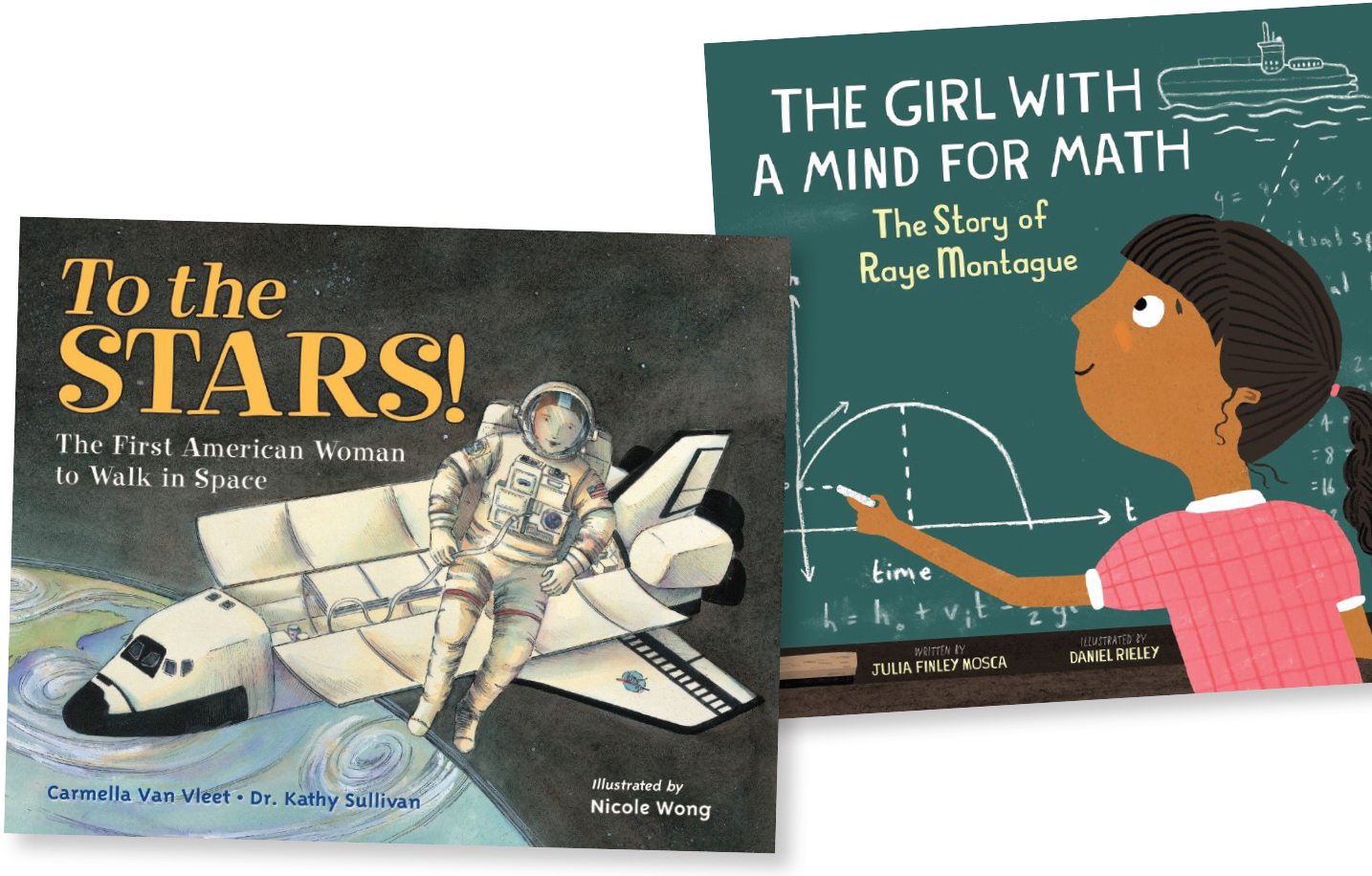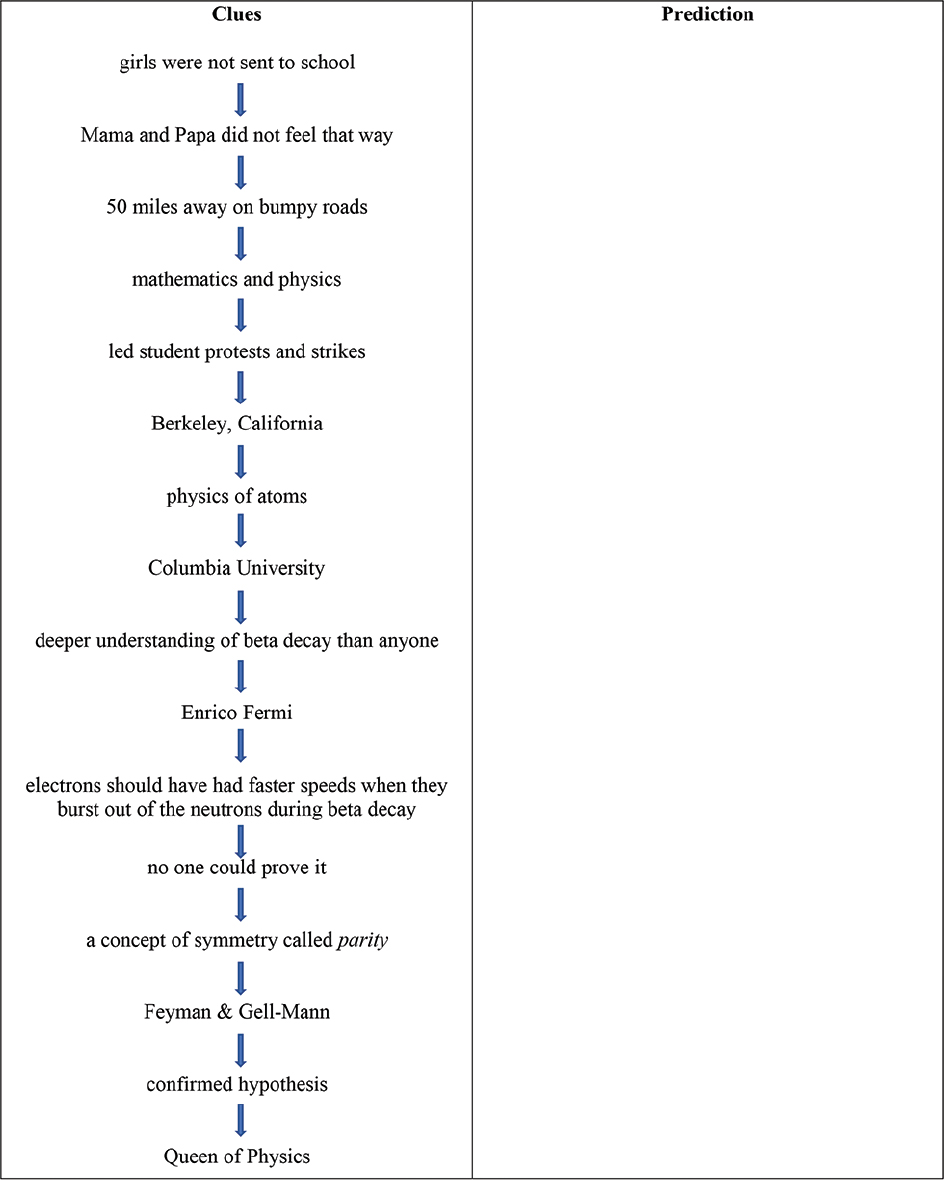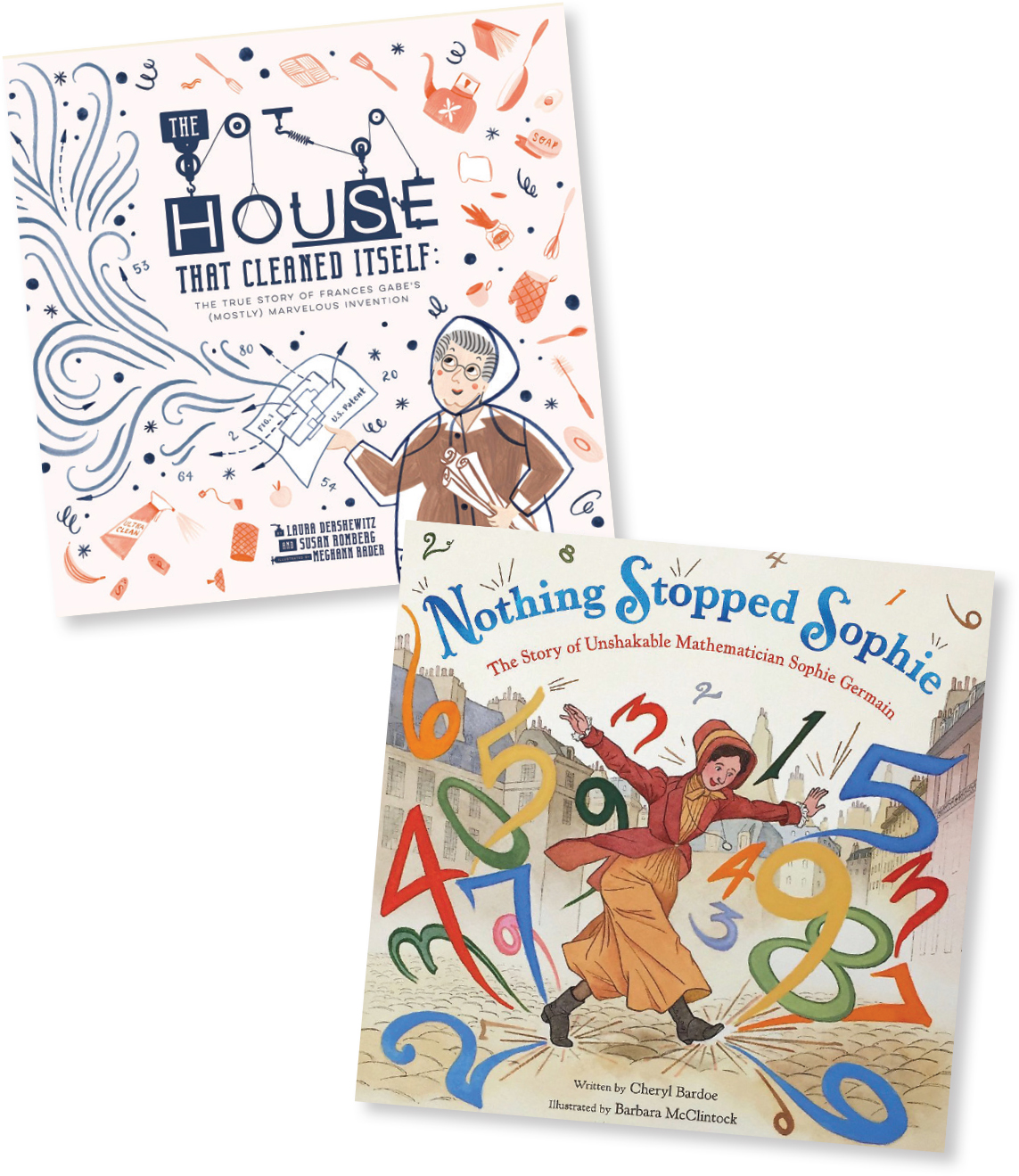feature
Utilizing Picture Books to Teach Through Notable Females in Science
Science Scope—November/December 2020 (Volume 44, Issue 2)
By Lisa M. Ciecierski, Jodie Styers, and Daniell DiFrancesa

Picture books are not just for young children. Actually, reading picture books with older students increases motivation, enhances the understanding of concepts, and builds aesthetic appreciation for the topics studied (Carr et al. 2001). They can serve as fundamental resources to enhance the curriculum and present alternatives to textbooks (Massey 2015). They can provide more information than a sole textbook (Vacca et al. 2009). When engaging with these books, the reader needs to use the synergistic relationship between the pictures and the text to gain full meaning of what is being communicated. As students utilize multiple modalities to read both the pictures and the words in a text, there is a potential for deeper learning.
Visual scaffolding is provided in a picture book, which may be particularly beneficial for students identified as English language learners (ELLs), those with exceptional abilities, and other students requiring support. Although the pictures can stimulate thinking, they can also provide support for students. For example, ELL students rely on “contextual clues to construct content area meaning in a language they do not fully master” (Rubinstein-Avila 2003, p. 130).
Picture books build background knowledge and increase motivation when utilized in the discipline specific classrooms. When reading picture books, students are brought into the topic in a transactional way. Students immerse themselves in experiences as they relate to individuals featured in picture books (Batchelor 2017). In this sense, the picture book is used as a “way-in” text, to stimulate interest in the topic being studied. Way-in texts are high-quality texts that provide students with an unexpected entry as they build curiosity and interest in a topic (Bintz 2011; Keene and Zimmerman 2007).
Recently, there have been many picture books written on notable figures in science. Some of these figures are popular but others are not as well-known, despite the importance of their contributions. While not necessarily popular, these Hallmark people have made remarkable contributions to the world we live in (Ciecierski and Bintz 2018). We have found in our years of experience in education that when we create a curriculum where students learn through books featuring figures in science, their curiosity is piqued, their motivation is stimulated, and their learning is more real and valued.
The books we chose to share in Figure 1 feature women as an underrepresented group in science; each may be utilized as a way-in text to introduce various topics in science. We recommend using these books as an anticipatory set to stimulate interest; increase background knowledge; and potentially serve as a tool to build relationships between science, the scientist, and the learner.
Way-in books for the science classroom.
|
Title |
NGSS standard |
Science/Engineering domain |
|
Hedy Lamarr’s Double Life: Hollywood Legend and Brilliant Inventor |
MS-PS4-3 |
Physical Science |
|
Ice Breaker: How Mabel Fairbanks Changed Figure Skating |
MS-PS2-2, 4 |
Physical Science |
|
Nothing Stopped Sophie: The Story of Unshakable Mathematician Sophie Germain |
MS-PS2 |
Physical Science |
|
Evelyn the Adventurous Entomologist: The True Story of a World-Traveling Bug Hunter |
MS-LS1-5 & |
Life Science |
|
Joan Proctor, Dragon Doctor: The Woman Who Loved Reptiles |
MS-LS1-5 |
Life Science |
|
Shark Lady: The True Story of How Eugenie Clark Became the Ocean’s Most Fearless Scientist |
MS-LS2-2 |
Life Science |
|
Ocean Speaks: How Marie Tharp Revealed the Ocean’s Biggest Secret |
MS-ESS2-2, 3 |
Earth & Space Science |
|
Out of School and Into Nature: The Anna Comstock Story |
MS-ESS3 |
Earth & Space Science |
|
To the Stars! The First American Woman to Walk in Space |
MS-ESS1 |
Earth & Space Science |
|
The House That Cleaned Itself: The True Story of Frances Gabe’s (Mostly) Marvelous Invention |
MS-ETS1-1, 2, 4 |
Engineering |
|
The Girl Who Had a Mind for Math: The Story of Raye Montague |
MS-ETS1-1, 2, 4 |
Engineering |
|
The World is Not a Rectangle: A Portrait of Architect Zaha Hadid |
MS-ETS1-1, 2, 4 |
Engineering |
Implementation
There might not be a better female to stimulate interest addressing standard “MS-PS1 Matter and Its Interactions” (NGSS Lead States, 2013, p. 49) than Wu Chien Shiung. The book Queen of Physics: How Wu Chien Shiung Helped Unlock the Secrets of the Atom (by Robeson; see Resources) does a remarkable job of sharing complex information in a way that is accessible, understandable, and has great potential to stimulate inquiry, leading the reader to want to know more.
Like many of the women featured here, Wu was born in a time when women were seen as housewives and mothers. The fact that Wu was Asian presented an additional barrier. In this time period, education was not valued for women but luckily for Wu, her parents felt differently. They laid the foundation for an amazing life full of numerous accomplishments, many of which are revealed by Robeson as she shares Wu’s story.
Wu is most known for her experiments in two areas. The first proved beta decay. The second disproved the Law of Parity, which predicted that radioactive atoms decay in a symmetrical way. Teens may be intrigued that Wu worked on the Manhattan Project and spent much time and effort on the study of atoms. Readers will not be surprised that Wu was named the Queen of Physics by Newsweek in 1963, winning the Comstock Award for her work with magnets, but they may be surprised to learn that she was overlooked for the Nobel Peace prize three times!

Story impression
To implement this book in the classroom, we suggest having students participate in creating a story impression (McGinley and Denner 1987). For this particular strategy, students read the key words listed vertically on the left side of a sheet of paper (see Figure 2). These words are chosen sequentially from the story and can be a mixture of events and vocabulary words. Thinking about all of the words together, students write a prediction for the book on the right-hand side of the paper. They do not need to use the specific words; they only need to think about them as a whole to write their prediction.

Story impression: Queen of Physics
As the teacher reads the book aloud to all students, or the students read the book in small groups or even individually, the students monitor their predictions. Which parts are accurate? Which are different than they anticipated? Students must actively monitor and reflect on their predictions to be successful at a story impression.
We have found several benefits to using this strategy with students: (1) students’ focus is strong as they actively monitor their prediction and look for similarities and differences between their prediction and the story itself; (2) students are introduced to vocabulary in context, which is an efficient and meaningful technique; (3) students’ background knowledge is built as they synthesize the words and phrases presented to them to formulate their prediction; (4) students’ interest is stimulated as they interact with the text followed by the content for the lesson
and/or unit of study; and (5) students are immersed in a valuable comprehension monitoring practice that can and should be applied when they read informational text found in science texts both in textbooks and articles.
Additional strategies
For the purpose of this article, we share “tried and true” instructional strategies. Practicing these strategies can help students build skills transferrable to informational text. Although these strategies may be familiar to literacy teachers, they can also serve as instructional strategies for science teachers. We have found that once you implement a few of the suggested strategies, you may choose to utilize their characteristics and blend them together to create your own.
Probable passages
Probable passages (Beers 2003) is a strategy used before students read a text. The purpose of using this strategy is to build vocabulary as well as an awareness of either the story structure or the text structure of the passage. To prepare the strategy, the teacher chooses 8–14 words or phrases and shares them with students, either in a list or even on small pieces of paper. Students organize the words into categories they believe are interrelated. Then, using the categorized words/phrases, they write a GIST statement, as a prediction, to share what they think the passage is going to be about. A GIST statement (Generating Interactions between Schemata and Texts) is a short, condensed statement that captures a bigger meaning; it is usually 20 words or less (Cunningham 1982; Herrell 2000).
As the text is read, students monitor their GIST statement and their groupings to determine if changes should be made. After reading the text, students discuss what the text was about, what changes they would make to their GIST statement, and how their prediction was similar and/or different from the actual text. This active thinking has the potential to deepen students’ comprehension and knowledge of the text and improves their ability to transition into learning the connected content.

FQR Think
FQR Think (Harvey and Goudvis 2007) is a strategy used while students are reading. The letters FQR stand for Fact, Question, Response, followed by Think. As students read, they actively monitor and record the facts they encounter. When implementing FQR Think in science class, the facts recorded are science facts. They may record them as notes, in an outline, or even as annotated marks made in the actual text.
Completing the following starters might help: I noticed, I saw, I remember, I read. Students should utilize all aspects of the text while reading and include both the written text and the visuals. They also actively construct questions and may further their learning from thinking about what they wonder as well as the who, what, where, when, how, and why of the reading.
The value of implementing the FQR Think strategy is the shift from responding after students read a passage to responding while reading. Engaging readers during reading rather than after they are done reading has the potential to increase comprehension and understanding of the text. Additionally, readers practice metacognitive skills while they read, which means they are actually thinking about their thinking as they read. This could enhance their knowledge (Reed et al. 2014).
Teachers may consider conducting a think aloud (Ness and Kenny 2016) to model this metacognitive thinking and the FQR Think strategy. A think aloud gives students the opportunity to hear what is going through the teacher’s mind because the teacher tells students exactly what they are thinking, what they are doing, and why they are doing it.
The FQR Think strategy can be used with any text, but may be best used with text that is difficult and requires deep thinking and frequent interaction.
Reciprocal teaching
Another strategy we value is the use of reciprocal teaching, which links to the importance of dialogue and learning. Reciprocal teaching engages students in important reading behaviors that they can apply to their independent reading. This technique gives teachers the opportunity to involve students in active dialogue as they interact and respond to others. The dialogue focuses on a segment of text the group is reading and is structured to bring together four comprehension strategies: (1) asking questions, (2) clarifying difficult words and ideas, (3) summarizing what has been read, and (4) predicting what might come next.
When this strategy is implemented in the classroom, the teacher first models and explains this comprehension strategy. Gradually, the teacher turns the activity over to the students. The complexity of the text and/or the concepts are raised to more challenging levels as students become more proficient.
To have students utilize the strategy themselves, they should be placed in groups. Each group should have a questioner, a clarifier, a summarizer, and a predictor. A short passage, or a section in a longer passage, is read by all members of the group. Each member enacts his or her assigned role/responsibility. The questioner will pose questions about the passage. These can be points that are unclear, information that is puzzling, or questions about connections to other parts of the piece or other readings. The clarifier addresses confusing parts and attempts to respond to the questions posed. The summarizer summarizes what has been read since the last stopping point. The predictor can offer predictions about what the author is going to write next. After the roles are completed, students assume a new role. The next portion of text is read with each student enacting their new role. This practice continues, with students actively interacting with the text, until they complete the reading.
Putting the practice into action
We suggest the following five-step framework for designing these lessons:
1. Consider the specific standard/skill you are teaching.
2. Think about picture books that might be particularly prevalent (we often consult NSTA’s annual “Outstanding Science Trade Books for Students K–12” publication).
3. Find/create a strategy to use so students are actively engaged while reading.
4. Read the book as an anticipatory set, using the instructional strategy.
5. Transition into the lesson, building on students’ piqued interest and now common background knowledge.
The implementation of these lessons may look different depending on the classroom and learning goals, but we have found that these books are best used as an anticipatory set to introduce a concept and stimulate interest. We often read the book to our whole class and sometimes project the book for students to see, a strong way to further increase engagement. We have also used the library to obtain multiple copies of the book and have students read the books in small groups.
Lessons learned and final thoughts
We have learned many lessons throughout our time in the classroom as we read a variety of texts on Hallmark people with students and engage students in a variety of learning strategies. Although we knew about the power of utilizing high-quality picture books as way-in texts with middle school students, our knowledge extended as we identified multiple books that focused on minority women who made significant contributions to scientific fields.
We also learned by analyzing these texts about the immense potential that exists to engage students in thinking critically and to foster interest not just in the book itself, but in the learning opportunities that can extend from it. We found that these extensions naturally lead to studying crosscutting concepts that transcend into other domains in science and other disciplines.
We hope that science teachers see this potential as well and utilize some of these books and instructional strategies in their classrooms to bring life to science topics. We are not suggesting that these books become the curriculum, but rather that they be used as way-in texts to promote as well as support students reading in science. •
Resources
Bardoe, C. 2018. Nothing stopped Sophie: The story of unshakable mathematician Sophie Germain. New York, NY: Little Brown Books for Young Readers.
Dougherty, R. 2019. Secret engineer: How Emily Roebling Built the Brooklyn Bridge. New York, NY: Roaring Brook Press.
Evans, C. 2019. Evelyn the adventurous entomologist: The true story of a world-traveling bug hunter. New York, NY: Innovation Press.
Keating, J. 2017. Shark lady!: The true story of how Eugenie Clark became the ocean’s most fearless scientist. Naperville, IL: Sourcebooks Explore.
Keating, J. 2020. Ocean speaks: How Marie Tharp revealed the ocean’s biggest secret. Toronto, Ontario, Canada: Tundra Books.
Lord, M. 2020. Patricia’s vision. New York, NY: Sterling Children’s Books.
McGinty, A.B. 2019. The girl who named Pluto: The story of Venetia Burney. New York, NY: Schwartz & Wade Books.
Mosca, J.F. 2018. The girl with a mind for math: The story of Raye Montague. New York, NY: Innovation Press.
Robeson, T. 2019. Queen of physics: How Wu Chien Shiung helped unlock the secrets of the atom. New York, NY: Sterling Children’s Books.
Romberg, S. 2019. The house that cleaned itself: The true story of Frances Gabe’s (mostly) marvelous invention. New York, NY: Innovation Press.
Slade, S. 2017. Out of school and into nature: The Anna Comstock story. Ann Arbor, MI: Sleeping Bear Press.
Valdez, P. 2018. Joan Proctor, dragon doctor: The woman who loved reptiles. New York, NY: Knopf Books for Young Readers.
Van Vleet, C., and K. Sullivan. 2016. To the stars! The first American woman to walk in space. Watertown, MA: Charlesbridge.
Vina, R. 2019. Ice breaker: How Mabel Fairbanks changed figure skating. Park Ridge, IL: Albert Whitman & Company.
Wallmark, L. 2019. Hedy Lamarr’s double life: Hollywood legend and brilliant inventor. New York, NY: Sterling Children’s Books.
Winter, J. 2017. The world is not a rectangle. New York, NY: Simon & Schuster Children’s Publishing Division.
References
Batchelor, K.E. 2017. Around the world in 80 picture books: Teaching ancient civilizations through text sets. Middle School Journal 8 (1): 13–26.
Beers, K. (2003). When kids can’t read: What teachers can do: A guide for teachers 6–12. Portsmouth, NH: Heinemann.
Bintz, W.P. 2011. “Way-in” books encourage exploration in middle grades classrooms. Middle School Journal 42 (3): 34–45.
Carr, K.S., D.L. Buchanan, J.B. Wentz, M.L. Weiss, and K.J. Brant. 2001. Not just for the primary grades: A bibliography of picture books for secondary content teachers. Journal of Adolescent & Adult Literacy 45 (2): 146–153.
Ciercierski, L., and W.P. Bintz. 2018. Learning through Hallmark People in the content areas. Middle School Journal 49 (1): 4–12. Doi: 10.1080/009040771.2018.1399329 (5)
Cunningham, J. 1982. Generating interactions between schemata and text. In New inquiries in reading research and instruction, ed. J.A. Niles and L.A. Harris, 42–47. Washington, DC: National Reading Conference.
Harvey, S., and A. Goudvis. 2017. Strategies that work: Teaching comprehension for engagement, understanding, and building knowledge, grades K–8. 3rd ed. Portland, ME: Stenhouse.
Herrell, A.L. 2000. Fifty strategies for teaching English language learners. Upper Saddle River, NJ: Merrill/Prentice-Hall.
Keene, E., and S. Zimmerman. 2007. Mosaic of thought: Teaching comprehension in a reader’s workshop. Portsmouth, NH: Heinemann.
Massey, S.R. 2015. The multidimensionality of children’s picture books for upper grades. English Journal 104 (5): 45–58.
McGinley, W., and P. Denner. 1987. Story impressions: A prereading/writing activity. Journal of Reading 31 (3): 248–253.
Ness, M., and M. Kenny. 2016. Improving the quality of think alouds. The Reading Teacher 69 (4): 453–460.
NGSS Lead States. 2013. Next Generation Science Standards: For states, by states. Washington, DC: National Academies Press. https://www.nextgenscience.org/dci-arrangement/ms-ps1-matter-and-its-interactions
Oczkus, L. (2018). Reciprocal teaching at work: Powerful strategies and lessons for improving reading comprehension. 3rd ed. Alexandria, VA: Association for Supervision and Curriculum Development.
Reed, D.K., E.A. Swanson, Y. Petscher, and S. Vaugn. 2014. The relative effects of teacher read-alouds and student silent reading on predominantly bilingual high school seniors’
learning and retention of social studies content. Reading and Writing: An Interdisciplinary Journal 27 (7): 119–1140. doi 10.1007/s11145-013-9478-8
Rubinstein-Avila, E. 2003. Facing reality: English language learners in middle school classes. English Education 35 (2): 122–130.
Vacca, J., R. Vacca, M. Gove, L. Burkey, L. Lenhart, and C. McKeon, C. 2009. Reading and learning to read. 7th ed. Boston, MA: Pearson.
Lisa M. Ciecierski (lmc61@psu.edu) is an assistant professor in the Department of Elementary and Early Childhood Education at Penn State Erie, The Behrend College, in Erie, Pennsylvania as well as the director of PennLake National Writing Project. Jodie L. Styers (jls982@psu.edu) is an associate teaching professor of mathematics education at Penn State Erie, the Behrend College. Daniell DiFrancesca (dqd5436@psu.edu) is an assistant professor of psychology at Penn State Erie, The Behrend College.
Careers Equity Inclusion Instructional Materials Literacy Multicultural NGSS Pedagogy Teaching Strategies


